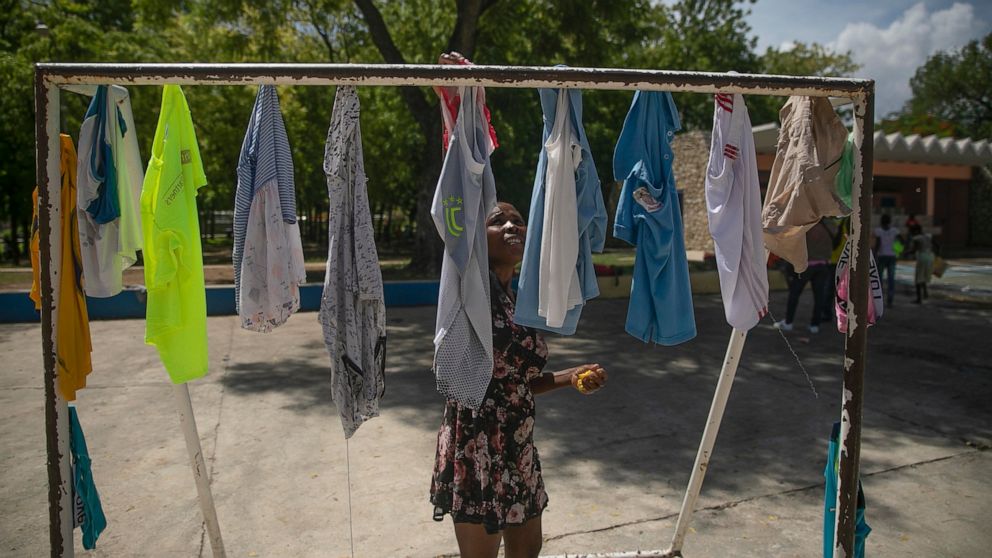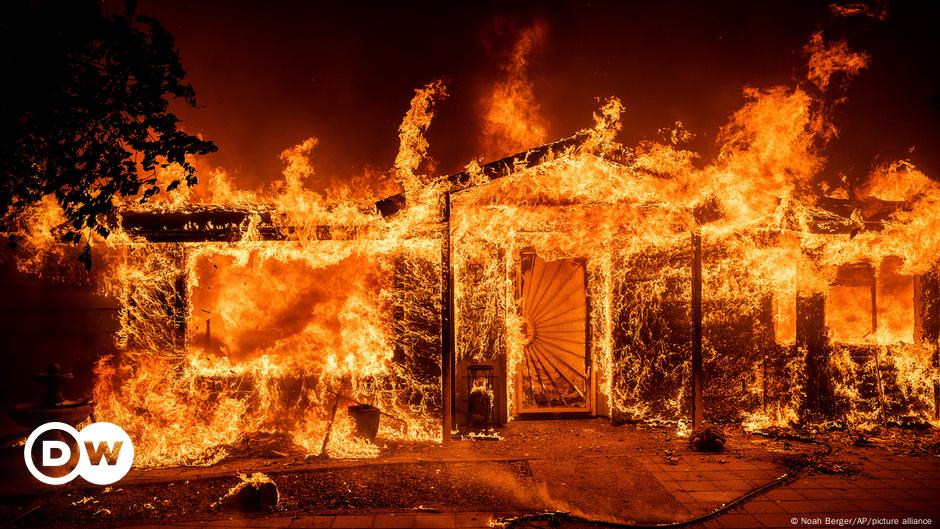However there’s nonetheless extra below his ft to be mined: Six extra villages are threatened.
A 56-year-old farmer, Heukamp is the final holdout in Lützerath, the following hamlet slated to be wiped away to permit extra digging for coal to energy German properties. He’s combating the pressured expropriation of the 18th-century farmhouse his household has lived in for generations, which now lies just some hundred yards from the mine’s edge.
As world leaders put together to come back collectively in Glasgow, Scotland, subsequent month for the U.N. Local weather Change Convention, the tiny neighborhood is on the entrance line in a battle to deliver Germany in accord with its local weather commitments — one among many such communities around the globe, as international locations wrestle to maintain up with formidable pledges to slash emissions.
The encroaching pit is a reminder of the contradictions of Germany’s environmental document: Outgoing Chancellor Angela Merkel has been on the forefront of worldwide diplomacy on local weather, however Europe’s largest financial system has struggled to kick its habit to coal.
Germany has pledged to cease burning coal by 2038, no less than eight years behind 16 different European international locations which have dedicated to ending coal use by the tip of this decade or earlier. There may be some hope that will change because the three events that made beneficial properties in September’s elections — together with Germany’s Greens — maintain talks to kind a brand new authorities. To date they’ve mentioned they’d “ideally” wish to see a 2030 coal exit.
“We need to be a front-runner on local weather. We promote ourselves as this,” mentioned Pao-Yu Oei, a professor within the economics of sustainable power transition on the Europe College of Flensburg. “However for some very simple, easy issues, we’re not keen to take the sacrifice and mainly tackle our personal foyer teams.”
Whereas it burns a fraction of the coal of China or america, within the European Union, Germany is the second-largest shopper of laborious coal, and the largest shopper of the less-energy-efficient lignite, or brown coal, which lies below Lützerath.
The concept that any villages should be sacrificed for the nation’s power wants are outdated by a couple of decade, mentioned Oei.
Destroying settlements and burning the coal beneath would imply Germany would fall in need of its commitments below the 2015 Paris local weather settlement, in accordance with a report Oei co-authored that was revealed by the German Institute for Financial Analysis and commissioned by organizations combating to avoid wasting the villages. The Paris settlement goals to restrict international warming to 1.5 levels Celsius (2.7 levels Fahrenheit) in contrast with preindustrial ranges.
“Germany has the technical means and so they have the financial means and the monetary means to maintain their electrical energy and power system with out having to destroy extra villages,” mentioned Oei.
In western North-Rhine Westphalia, the place Heukamp’s village of Lützerath lies, coal is ever-present.
Heaps adorn roundabouts, in a monument to the gas. RWE, the multinational energy firm that owns the pit, has arrange viewing and data factors across the mine’s edge.
“Capitalist s—,” reads a sticker slapped on one board in reference to the work of the pit’s 13,000-ton, 100-meter-high excavators, just like the one in Heukamp’s area. An excavator is able to extracting 240,000 tons of coal a day.
With its final black coal mines closed, Germany is the largest producer of brown coal on this planet.
Typically nearer to the floor than black coal, lignite is usually mined in large open-cast floor mines reasonably than underground. After the coal is gone, the soil is backfilled and replanted, however the panorama is irrevocably altered.
In all, the world RWE has the precise to mine round Lützerath stretches twice the scale of Manhattan.
Villages within the space have been pulled down for mining for many years. Some 35,000 folks have been pressured to surrender their properties for the reason that finish of World Struggle II.
Garzweiler I, on the opposite facet of a six-lane freeway, introduced an finish to greater than half a dozen villages, together with Garzweiler, after which the mine is called.
After coal there was exhausted, digging started on the opposite facet of the autobahn at Garzweiler II in 2006, with plans to displace a dozen extra communities and 1000’s of residents. They’ve disappeared, one after the other.
RWE says that it’s totally compliant with Germany’s present coal exit plan and that every one three of its lignite mines will probably be closed sooner than deliberate. In return for doing so, RWE obtained a 2.6 billion euro payout from the federal government.
Relocations are averted the place attainable, mentioned spokesman Guido Steffen, including that close by Inden mine can’t be expanded as a substitute as there is no such thing as a rail hyperlink to the corporate’s extra trendy energy crops.
The coal of Lützerath is required within the close to future, he mentioned, and the coal below the neighboring 5 villages within the subsequent “few years” to produce RWE’s energy crops.
Lützerath was as soon as a close-knit neighborhood of about 90 folks, Heukamp mentioned. However his neighbors have slowly bought and left. Within the courtyard of his farm, close to his tractors and mix harvester, lies a pile of gravestones.
Household graves needed to be exhumed and relocated within the final village to be flattened for the mine. There isn’t any longer any signal of the church that was pulled down regardless of its being a protected constructing.
Heukamp has already been displaced by mining. In 2015, he moved from one other village that was cleared to make manner for the pit and returned to the household farm. He says RWE will not be providing him sufficient compensation for his property to purchase one thing equal.
“The monetary performs a job, however in fact it’s an emotional story to go away this farm,” he mentioned. “Residence is a vital a part of life for me.”
As villagers have slowly moved out, dozens of activists have moved in. “Defend Lützerath, Defend 1.5°C,” reads an indication that Heukamp held up alongside Swedish local weather activist Greta Thunberg throughout a current go to.
Treehouses dot a copse of bushes between Heukamp’s farmhouse and the mine’s edge. A gully holds dozens of tents.
A lady who goes by the title Salome Dorfer, 25, lives in a treehouse about 26 ft up a towering oak. She’s been right here for the previous yr. Dorfer is the title she makes use of for her activism, as she mentioned she fears that utilizing her actual title might harm her employment prospects.
Lützerath’s new residents say they received’t go away and not using a struggle to avoid wasting the village.
“We’re making ready ways to mainly block the roads once they include their working tools,” she mentioned, touring the positioning barefoot on a current wet day in October. “We’ll make it as large as attainable to indicate the world that we have to change this, that we will’t simply act as common within the midst of a local weather disaster.”
The German authorities had not anticipated to fulfill its 2020 emissions discount goal, however limped over the road because of the pandemic. However it’s anticipated to slide again under its goal this yr because the nation returns to enterprise as common.
Nonetheless, it has set formidable new targets: a 65 p.c minimize in emissions from 1990 ranges by 2030, and reaching 88 p.c a decade later. The federal government was pressured to scramble to replace its local weather regulation this yr after the nation’s highest courtroom dominated that it fell so brief it primarily endangered the basic rights and freedoms of the nation’s youth.
Specialists say it must replace its coal phaseout plans to achieve these targets. The share of electrical energy Germany makes from coal has dropped considerably lately, but it surely nonetheless accounts for greater than 1 / 4 of the nation’s energy provide.
Germany’s 2038 aim seems more and more out of step with Europe’s bigger economies. Britain says it’s phasing out coal by 2024, France by 2022 and Italy by 2025.
Making it harder for Germany is its determination to part out nuclear by 2022 within the wake of Japan’s 2011 Fukushima catastrophe, plus its giant manufacturing business. Specialists say Germany must quickly ramp up renewables to fill the hole, however hovering gasoline costs might complicate efforts for that transition, with fears it might enhance electrical energy payments even additional.
Coal is reasonable and plentiful. And bringing the exit date additional ahead will imply extra payouts to coal firms. However Germany is below stress to take action from a number of fronts.
Even when the coal exit date is modified, it’s not clear if it’s going to are available in time for Lützerath. A number of homes reverse Heukamp’s farm have been pulled down in January.
“The time is tight,” mentioned Heukamp. If his authorized efforts fail, he will be evicted as quickly as November.
However there may be extra hope for residents of 5 different threatened villages somewhat farther from the sting of the pit.
‘The nothing reaches you’
Down the highway within the village of Kuckum, the Dresen household now assume they may have the ability to keep within the dwelling the place their household has lived for generations. With their village earmarked for demolition since 1995, the looming risk of displacement has been ever-present in 21-year-old Tina Dresen’s life.
“As a child you have been all the time considering, to the left, there’s this gap,” she mentioned. “And there may be solely unhappiness. It’s such as you’ve been dwelling subsequent to nothing, and the nothing reaches you.”
The household had initially thought promoting was inevitable, however then the remaining nook of Hambach Forest — the earlier symbolic heart of environmentalists’ struggle towards Germany’s coal coverage — was saved when the federal government introduced ahead its coal exit date.
“Then we thought it’s attainable to win this struggle,” mentioned Tina’s brother David Dresen, 30, an activist with Alle Dörfer Bleiben, or All Villages Keep, an area group combating to avoid wasting the villages.
The vast majority of their neighbors have already gone. “Empty, empty, empty,” he mentioned, pointing to the redbrick homes that line the highway.
Two-thirds have already bought, in accordance with RWE letters posted to residents earlier this yr, urging them to resettle, a course of that has been ongoing for the previous 5 years. The corporate says it goals to maneuver the village residents collectively, in a technique of “joint resettlement” that has “stood the check for many years now in preserving a village neighborhood.”
Households are supplied a plot in a brand new village that they will purchase and construct on from the cash supplied to them for his or her property by RWE. Most attain an amicable settlement, it says. People who don’t will be forcibly evicted based mostly on a German regulation that enables expropriations for the “larger good.”
About half of those that have left have moved out of the world fully.
The Dresens will not be satisfied by the thought of a life in New Kuckum. Three generations of their household dwell throughout the previous farmhouse and a more recent conversion in what was as soon as the cow shed. There’s an orchard and paddocks for 3 horses out again, on a property stretching over three acres.
They are saying they will’t rebuild a spot like they what have now, and that they’re being supplied the choice to purchase a half-acre plot within the new village, the place there could be no house for the animals.
Clumped along with a gaggle of different “new” villages, between a freeway and a railway line, the brand new improvement bears little resemblance to the previous communities. Unfinished streets are lined with boxy new properties in what appears like a nondescript suburb.
“It has the identical avenue names, that’s it,” mentioned David Dresen.
However even when the villages are saved, many really feel these communities are damaged past restore — already divided by the resettlement course of.
It seeped into the lecture rooms in school, the place there was stress from different youngsters on these from households that have been holding out. And now that there’s an opportunity that the villages may stay, some households who left are regretting it.
“They’re offended with the individuals who stayed, as a result of we’re a reminder that they might have,” mentioned Tina Dresen.
A few of those that have bought are saying they need to have the precise to purchase their homes again. Others accuse those that have held out of splitting the neighborhood and say that in the event that they have been pressured to promote for it to be flattened, it must be. The tensions have boiled over on social media.
“There are extremes on either side,” mentioned Hans Josef Dederichs, an area councilor for the Greens, in a sterile, spartan new constructing in New Kuckum.
“This open-pit mine is the worst factor that may occur to you; the neighborhood is torn aside by it,” mentioned Dederichs, who can also be president of the native “rifle brotherhood,” a membership that organizes neighborhood occasions. There’s battle, he mentioned, however one factor that everybody is now agreed on: It’s trying more and more just like the upheaval right here wasn’t even vital.
“It was all in useless,” he mentioned.
Katharina Köll contributed to this report.

















